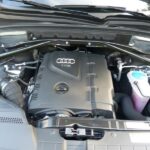The BMW M57 engine, known for its robust performance, can sometimes encounter issues indicated by fault codes. One common code is the 4530 fault code, signifying a problem with the charge air pressure control system, specifically indicating that the charge-air pressure is too low. Understanding this fault code and its potential causes is crucial for effective diagnosis and repair.
Understanding the 4530 BMW Fault Code
The 4530 fault code, often accompanied by a “Reduced Engine Power” message and the illumination of the Service Engine Soon lamp, points towards a deviation in the charge air pressure control system, resulting in pressure that’s lower than expected. This can impact engine performance and fuel efficiency. While a faulty vacuum canister can contribute to this issue, as it impacts the vacuum system controlling various components including turbocharger wastegates, it’s crucial to explore all potential causes. BMW has issued a Service Information Bulletin (SI B12-10-09) specifically addressing the diagnosis of fault codes 4521 (charge-air pressure too high) and 4530 in E90 and E70 models equipped with the M57Y diesel engine.
Potential Causes of the 4530 Fault Code
According to SI B12-10-09, the potential causes of the 4530 fault code include:
-
Charge Air Leaks: Leaks in the system between the turbochargers and the intake manifold can cause a drop in boost pressure, triggering the fault code. This is a common issue and often requires a thorough inspection of hoses, clamps, and intercooler connections.
-
Clogged Air Filter/Intake Path: A restricted airflow due to a clogged air filter or obstructions in the intake path before the turbocharger can also lead to low charge air pressure.
-
Turbocharger Actuator Malfunction: Issues with the turbocharger actuators, such as insufficient vacuum supply to the wastegates or a jammed compressor bypass valve, can disrupt boost pressure regulation. The vacuum canister plays a vital role in providing the necessary vacuum for these actuators.
-
Intake Manifold Pressure Sensor Issues: A faulty pressure sensor can provide inaccurate readings to the DDE control module, leading to misdiagnosis and the 4530 fault code.
-
Excessive Exhaust Backpressure: High backpressure in the exhaust system can hinder the turbocharger’s ability to generate sufficient boost. This could be due to a clogged catalytic converter or other exhaust restrictions.
Diagnostic Procedures for the 4530 Fault Code
BMW SI B12-10-09 specifically advises against using the ISID test module B1365_D7LMS (Air Mass System Test) for diagnosing faults 4521/4530 in the M57Y US engine version. This test module may yield inaccurate results, potentially leading to unnecessary component replacement.
Instead, the bulletin recommends performing the following test modules:
-
B1362_D6TRK: Tests the wastegate control of the smaller turbocharger.
-
B1362_D6WGV: Tests the wastegate control of the larger turbocharger.
-
B1362_D6VBK: Tests the multistage turbocharging system specific to the US diesel version.
Additionally, a smoke test using BMW-approved equipment (such as the VACUTEC Smoke Machine 625-522B-BMW) is recommended to check for leaks in the intake system.
Resolving the 4530 Fault Code
Resolving the 4530 fault code requires accurately identifying the underlying cause. This involves systematically inspecting and testing the components mentioned above. Replacing a brittle or failing vacuum canister might be a necessary step, especially if it’s impacting the operation of the turbocharger wastegates. However, a comprehensive diagnosis following BMW’s guidelines is crucial to avoid unnecessary repairs. Addressing the root cause will restore proper boost pressure, resolve the fault code, and return the engine to optimal performance.

